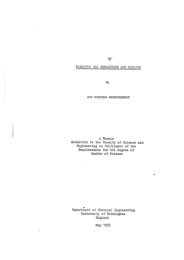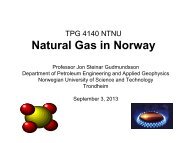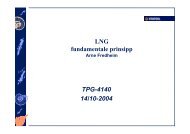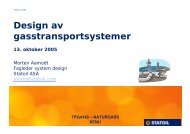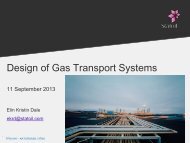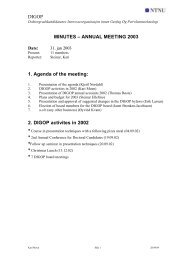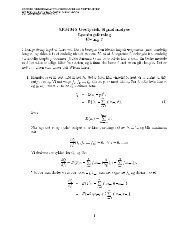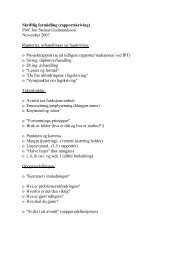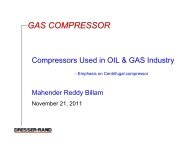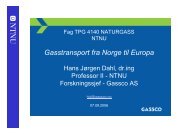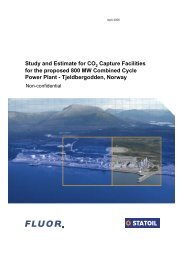Hydrates and Glycols - NTNU
Hydrates and Glycols - NTNU
Hydrates and Glycols - NTNU
Create successful ePaper yourself
Turn your PDF publications into a flip-book with our unique Google optimized e-Paper software.
<strong>Hydrates</strong> <strong>and</strong> <strong>Glycols</strong><br />
MEG (Mono Ethylene glycol) Injection <strong>and</strong> Processing<br />
<strong>NTNU</strong> september 9, 2010<br />
Kristian S<strong>and</strong>engen<br />
Classification: Internal 2010-08-25
Agenda<br />
•General Introduction<br />
•“chemical” challenges for long multiphase flowlines<br />
–<strong>Hydrates</strong><br />
–Corrosion<br />
–Scale<br />
•How do we battle these problems?<br />
•Use of Glycol (MEG) as hydrate inhibitor<br />
–What do we mean by a MEG loop?<br />
–MEG regeneration<br />
• Note: MEG is a common antifreeze agent, used e.g. in cars.<br />
Classification: Internal 2010-08-25<br />
MEG= Mono Ethylene Glycol
Midgard/Mikkel Tie-in on Åsgard<br />
Classification: Internal 2010-08-25
Why are we using MEG?<br />
Low temp, high pressure <strong>and</strong> water????<br />
Colder: Water condense – Multiphase flow<br />
Reservoir gas contains water<br />
dissolved as H 2<br />
O molecules<br />
in the gas<br />
MEG<br />
Classification: Internal 2010-08-25<br />
MEG= Mono Ethylene Glycol
Water condensation<br />
•Water in gas<br />
–Water condense at low T<br />
–Water evaporate at low P<br />
90<br />
80<br />
1.4<br />
1.2<br />
•At 5°C<br />
–95-99% of water has<br />
condensed<br />
Condensed water volume (m3/d)<br />
70<br />
60<br />
50<br />
40<br />
30<br />
20<br />
10<br />
Water in gas (mol%)<br />
Condensed water volume<br />
1<br />
0.8<br />
0.6<br />
0.4<br />
0.2<br />
Water in gas (mol%)<br />
Vega example:<br />
Gas 7 MSm 3 /d<br />
FW 10 m 3 /d<br />
P 150-85 bar<br />
T 110-5 °C<br />
0<br />
120<br />
100<br />
80 60 40<br />
Flowline temperature (°C)<br />
20<br />
0<br />
0<br />
Classification: Internal 2010-08-25
<strong>Hydrates</strong><br />
•Hydrate is water in a solid structure with small gas molecules in cavities<br />
–Much like snow/ice<br />
• Water freeze at 0ºC, what about hydrates?<br />
•Requirements for hydrate formation<br />
–Free water<br />
–Small gas molecules (N 2 , CO 2 , CH 4 , C 2 ,C 3 ,…)<br />
–Low temperature<br />
–High pressure<br />
Classification: Internal 2010-08-25
Hydrate phase diagram<br />
Hydrate equilibrium curve<br />
Water Gas Hydrate<br />
200<br />
180<br />
160<br />
140<br />
Hydrats can form<br />
Pressure (bar)<br />
120<br />
100<br />
80<br />
Equilbrium curve<br />
60<br />
40<br />
20<br />
0<br />
Hydrats can NOT form<br />
0 5 10 15 20 25<br />
Temperature (°C)<br />
Classification: Internal 2010-08-25
Water in pipeline - problems<br />
•Water condensates<br />
•Low T -High P -Free water<br />
=> Hydrate formation<br />
Well<br />
P High<br />
T High<br />
Pipeline<br />
P High<br />
T Low<br />
Classification: Internal 2010-08-25
Hydrate equilibrium curve<br />
200<br />
180<br />
Hydrate prevention<br />
Pressure (bar)<br />
160<br />
140<br />
120<br />
100<br />
80<br />
Hydrats can form<br />
Equilbrium curve<br />
60<br />
•How to avoid hydrate formation<br />
–Keep temperature high<br />
–Keep pressure low<br />
–Dilute water<br />
40<br />
20<br />
Hydrats can NOT form<br />
0<br />
0 5 10 15 20 25<br />
Temperature (°C)<br />
Water Gas Hydrate<br />
•Dilute water means separating water molecules <strong>and</strong> make it more difficult<br />
for them to react.<br />
Classification: Internal 2010-08-25
Hydrate prevention<br />
•How to avoid hydrate formation<br />
–Keep temperature high<br />
–Keep pressure low<br />
–Dilute water<br />
Water Gas Hydrate<br />
•Dilute water means separating water molecules <strong>and</strong> make it more difficult<br />
for them to react.<br />
•We need to add something:<br />
–Salts works<br />
–Alcohol works (example methanol)<br />
–Glycol works (example MEG <strong>and</strong> TEG)<br />
Classification: Internal 2010-08-25
Hydrate prevention<br />
•Hydrate formation reaction (simplified)<br />
•Chemical potential<br />
–If <br />
0<br />
reaction will go<br />
l gas H O hyd<br />
<br />
H<br />
2O<br />
<br />
2<br />
<br />
hyd l<br />
HO HO gas<br />
2 2<br />
•Chemical potential of gas is mainly given by pressure <strong>and</strong> temperature<br />
<strong>and</strong> can normally not be changed<br />
•Chemical potential of hydrate can not be changed<br />
•Chemical potential of water<br />
l<br />
<br />
<br />
RT ln a RT ln x<br />
H O H O H O H O H O H O<br />
2 2 2 2 2 2<br />
–If we dilute water to get x H2O lower, the chemical potential of water will be<br />
lower <strong>and</strong> the reaction is shifted to the left -> no hydrates<br />
Classification: Internal 2010-08-25
Hydrate prevention – diluting the water<br />
•<strong>Hydrates</strong> can be prevented with “anything” that reduces the molefraction<br />
of water<br />
60<br />
Hydrate inhibition effect<br />
Decrease in Hydrate temperature (C)<br />
50<br />
40<br />
30<br />
20<br />
10<br />
dT MeOH<br />
dT Ethylene Glycol<br />
dT Diethylene Glycol<br />
Nielsen <strong>and</strong> Bucklin<br />
Alcohols<br />
Salt<br />
0<br />
0 0.1 0.2 0.3 0.4 0.5 0.6<br />
Molefraction inhibitor<br />
T<br />
72ln 1x<br />
<br />
Inhib<br />
<br />
Classification: Internal 2010-08-25
Thermodynamic Hydrate inhibitors<br />
•MEG (Mono Ethylene Glycol)<br />
inhibits hydrate formation<br />
–Freezing point lowered<br />
Pressure [bar]<br />
450<br />
400<br />
350<br />
300<br />
250<br />
200<br />
150<br />
100<br />
50<br />
<strong>Hydrates</strong><br />
M E G<br />
No inhib<br />
20% MEG<br />
40% MEG<br />
No hydrates<br />
0<br />
0 5 10 15 20 25 30<br />
Temperature [C]<br />
Inhibitor<br />
Water<br />
MeOH<br />
MEG<br />
TEG<br />
Density<br />
1.0<br />
0.79<br />
1.11<br />
1.12<br />
Viscosity (cp-25 o C)<br />
0.89<br />
0.5<br />
18<br />
36<br />
Freezing Point<br />
0 o C<br />
-94 o C<br />
-13 o C<br />
-5 o C<br />
Boiling Point<br />
100 o C<br />
65 o C<br />
198 o C<br />
278 o C<br />
Classification: Internal 2010-08-25
Type of inhibitor MeOH vs. MEG<br />
Fire/explosion hazard<br />
Health hazard<br />
Environmental impact<br />
Regeneration<br />
Salt solubility (scale)<br />
Quality<br />
Pumping (friction loss)<br />
Efficiency as hydrate inhibitor<br />
(remember that on a mole basis all inhibitors are ~equal)<br />
Loss of chemical to gas phase<br />
MeOH<br />
+<br />
+<br />
(more per Kg or L)<br />
?<br />
MEG<br />
+<br />
+<br />
+(?)<br />
+<br />
?<br />
+<br />
Classification: Internal 2010-08-25
Water in pipeline - problems<br />
•Water condensates<br />
•Low T - High P - Free water<br />
=> Hydrate formation<br />
•CO 2<br />
dissolved in condensed water<br />
CO 2 is a weak acid<br />
pH very low => Corrosion<br />
Typical pH~4<br />
Well<br />
P High<br />
T High<br />
Pipeline<br />
P High<br />
T Low<br />
Classification: Internal 2010-08-25
Corrosion inhibitor<br />
•For corrosion to occur, there has to be water in contact with the steel<br />
–Long pipelines = large quantities<br />
–Corrosion inhibitor (CI) often environmentally unfriendly<br />
Absorbing end<br />
Inhibitor<br />
Hydrophobic end<br />
H2O<br />
H2O<br />
H2O<br />
Classification: Internal 2010-08-25
Corrosion protection - “pH Stabilization”<br />
Initial FeCO 3<br />
precipitation<br />
Fe<br />
2<br />
<br />
CO<br />
2<br />
3<br />
<br />
FeCO<br />
3 (<br />
solid)<br />
Protective<br />
FeCO 3<br />
film<br />
Classification: Internal 2010-08-25
Corrosion<br />
Corrosion<br />
•Long pipelines: Carbon steel<br />
•Condensed water has no buffer capacity<br />
–CO 2 in gas -> pH=3.5 - 4.5<br />
•After start-up on Kollsnes they produced about 20 tons of iron!<br />
–Plugged: Heat exchangers, separators, filters, centrifuges etc.<br />
Classification: Internal 2010-08-25
pH stabilization<br />
Fe<br />
2<br />
CO<br />
2<br />
3<br />
FeCO<br />
3 (<br />
solid)<br />
•Increase pH in pipeline<br />
– Alkaline addition (NaOH) to leanMEG to<br />
form CO 3<br />
2-<br />
– Higher pH – less corrosive<br />
– Formation of FeCO 3<br />
protective film<br />
<br />
Kollsnes pH stabilization<br />
Decrease in iron concentration<br />
Classification: Internal 2010-08-25
What is scale?<br />
Scale is precipitation of inorganic<br />
salts (minerals) in production<br />
equipment.<br />
Classification: Internal 2010-08-25
Formation water – scale problem<br />
MEG/MeOH + Na 2 CO 3<br />
Scale<br />
P High<br />
T High<br />
Pipeline<br />
P High<br />
T Low<br />
Well<br />
Formation<br />
water<br />
•MEG/MeOH reduce salt solubility<br />
•Mixing point!<br />
– Ca 2+ from reservoir : Ca 2+ + CO 3<br />
2-<br />
= CaCO 3<br />
– Reacts with carbonate in the exact same manner as the (wanted) reaction with iron (Fe 2+ )<br />
Classification: Internal 2010-08-25
pH stabilization<br />
Fe<br />
2<br />
CO<br />
2<br />
3<br />
FeCO<br />
3 (<br />
solid)<br />
•Increase pH in pipeline<br />
– Alkaline addition (NaOH) to leanMEG to<br />
form CO 3<br />
2-<br />
– Higher pH – less corrosive<br />
– Formation of FeCO 3<br />
protective film<br />
<br />
Kollsnes pH stabilization<br />
Decrease in iron concentration<br />
Classification: Internal 2010-08-25
Scale<br />
pH stabilization<br />
Fe<br />
2<br />
2<br />
Ca<br />
CO<br />
2<br />
3<br />
<br />
CaCO<br />
3 (<br />
solid)<br />
Kollsnes pH stabilization<br />
•Increase pH in pipeline<br />
– Alkaline addition (NaOH) to leanMEG to<br />
form CO 3<br />
2-<br />
Calcium comes from the formation water<br />
Classification: Internal 2010-08-25
A typical MEG loop<br />
Pipeline<br />
Rich MEG<br />
MEG: 60 wt%<br />
Rate: 220-300 m 3 /d<br />
Process plant with<br />
MEG regeneration<br />
Water <strong>and</strong> waste<br />
Rate: 70-110 m 3 /d<br />
Wells<br />
Water<br />
Condensed water: 70-100 m 3 /d<br />
Formation water: 0-10 m 3 /d<br />
MEG injection line<br />
Lean MEG<br />
MEG: 90 wt%<br />
Rate: 150-200 m 3 /d<br />
Classification: Internal 2010-08-25
Thermodynamics<br />
•Mono Ethylene Glycol (MEG)<br />
–MEG has a higher boiling point than water!<br />
–By heating one can distil water-MEG mixtures<br />
• Water prefers gas phase<br />
• MEG prefers liquid phase<br />
Classification: Internal 2010-08-25
MEG regeneration<br />
Rich MEG<br />
MEG 50-70 wt%<br />
(MEG + Water)<br />
MEG regeneration<br />
Lean MEG<br />
MEG 90 wt%<br />
Water<br />
Classification: Internal 2010-08-25
Water removal (regeneration)<br />
Kollsnes<br />
Pressure: 1.1-1.3 bar<br />
Temperature: 140-150°C<br />
Snøhvit<br />
Classification: Internal 2010-08-25
Cooling water<br />
Heat exchanger<br />
Classification: Internal 2010-08-25
Recycle heater<br />
Classification: Internal 2010-08-25
Energy consumption<br />
•Water must be evaporated!<br />
Water<br />
MEG<br />
–Example:<br />
• Feed: 300 m 3 /d 60 wt% MEG<br />
• Feed temp: 30°C, boiling temp, 120°C<br />
Heat capacity (kJ/ kg K) 4.16 3.1<br />
Heat of vaporization (kJ/kg) 2603 968<br />
–Answer:<br />
• MEG<br />
• H 2 O<br />
180 m 3 /d=180 000 kg/d<br />
120 m 3 /d=120 000 kg/d<br />
–Heating from 30 to 120°C<br />
• MEG 180 000*3.10*90=5.02*10 7 kJ/d = 580 kW<br />
• H 2 O 120 000*4.16*90=4.49*10 7 kJ/d = 520 kW 1 100 kW<br />
–Vaporization<br />
• Not all water is evaporated (only to get 90wt% MEG)<br />
• H 2 O 90 000*2603=3.12*10 8 kJ/d = 2711 kW 2 700 kW 3.8 MW<br />
Classification: Internal 2010-08-25
MEG regeneration<br />
Rich MEG<br />
MEG 50-70 wt%<br />
(MEG + Water)<br />
MEG regeneration<br />
Lean MEG<br />
MEG 90 wt%<br />
Water<br />
Classification: Internal 2010-08-25
MEG regeneration<br />
Rich MEG<br />
MEG regeneration<br />
Lean MEG<br />
MEG 50-70 wt%<br />
Water<br />
pH stabilizer<br />
Salts<br />
Corrosion products<br />
other production chemicals<br />
Hydrocarbons<br />
MEG 90 wt%<br />
Water & Waste<br />
Classification: Internal 2010-08-25
Salt removal (reclamation)<br />
Vacum<br />
pump<br />
•Need to remove<br />
something!<br />
–Dissolved<br />
salt/chemicals etc.<br />
–Removal<br />
• Up concentrate<br />
until “pollutants”<br />
solidify<br />
• Remove solid<br />
material<br />
–Evaporate all<br />
water+MEG<br />
Salt<br />
feed<br />
Flash<br />
separator<br />
Snøhvit<br />
Salt free<br />
vapour<br />
Circulation pump<br />
Heat<br />
exchanger<br />
Lean MEG<br />
Vacum<br />
reciever<br />
Water<br />
Pressure: 0.1-25 bar<br />
Temperature: 110-130°C<br />
Solids removal<br />
Classification: Internal 2010-08-25
Energy consumption - reclamation<br />
•In a reclaimer, both MEG <strong>and</strong> water is evaporated<br />
–Example:<br />
• Feed: 300 m 3 /d 60 wt% MEG<br />
• Feed temp: 30°C, boiling temp, 120°C<br />
Water MEG<br />
Heat capacity (kJ/kg K) 4.16 3.1<br />
Heat of vaporization (kJ/kg) 2603 968<br />
–Answer:<br />
• MEG<br />
• H 2 O<br />
180 m 3 /d=180 000 kg/d<br />
120 m 3 /d=120 000 kg/d<br />
–Heating from 30 to 120°C<br />
• MEG 180 000*3.10*90=5.02*10 7 kJ/d = 580 kW<br />
• H 2 O 120 000*4.16*90=4.49*10 7 kJ/d = 520 kW 1 100 kW<br />
–Vaporization<br />
• MEG 180 000*968 =1.74*10 8 kJ/d = 2 016 kW<br />
• H 2 O 120 000*2603=3.12*10 8 kJ/d = 3 615 kW 5 631 kW 6.7 MW<br />
Classification: Internal 2010-08-25
MEG recovery<br />
•MEG regeneration<br />
–Only water is evaporated<br />
–MEG passes through the<br />
facility as liquid phase<br />
–Any salts, chemicals etc.<br />
remains in the MEG<br />
–i.e. MEG loop can be<br />
”polluted”<br />
•MEG reclamation<br />
–Both water <strong>and</strong> MEG is<br />
evaporated<br />
–Salts, chemicals etc. are left<br />
behind in the liquid phase<br />
–i.e. salts/chemicals can be<br />
removed<br />
Classification: Internal 2010-08-25
Solids removal<br />
•Sediment Tanks<br />
–Onshore<br />
•Centrifuges<br />
–Offshore<br />
Classification: Internal 2010-08-25
Hydrate equilibrium curve<br />
200<br />
What have we learned?<br />
HYDRATES<br />
Pressure (bar)<br />
180<br />
160<br />
140<br />
120<br />
100<br />
80<br />
Hydrats can form<br />
Equilbrium curve<br />
40<br />
•<strong>Hydrates</strong><br />
20<br />
–An ice/snow like solid<br />
0<br />
–Forms at low temperature <strong>and</strong> high pressure<br />
• Need water (liquid or solid) + small molecules (e.g. CH 4 , C 2 H 6 )<br />
–Reversible reaction<br />
• i.e. can be removed by de-pressurization or heating<br />
•Hydrate formation can be inhibited by:<br />
–Anything that dilutes water i.e. is mixable with water<br />
• Salt<br />
• Alcohol<br />
–Works because water molecules are separated<br />
60<br />
Hydrats can NOT form<br />
0 5 10 15 20 25<br />
Temperature (°C)<br />
•MEG<br />
–Denotes Mono Ethylene Glycol<br />
• Is an alcohol<br />
–Used as antifreeze agent in cars<br />
–Much used as hydrate inhibitor in oil industry<br />
• Methanol <strong>and</strong> ethanol are other much used chemicals<br />
Classification: Internal 2010-08-25
What have we learned?<br />
CHEMISTRY<br />
•Corrosion<br />
–A problem in long carbon steel pipelines<br />
• Water from condensation + acidic environment due to CO 2<br />
–Can be avoided by addition of an alkaline chemical<br />
• E.g. NaOH (caustic soda)<br />
• Forms a protective, self-healing, film of FeCO 3<br />
2<br />
2<br />
Fe CO3<br />
FeCO solid)<br />
3(<br />
Liquid<br />
FeCO 3<br />
Metal<br />
•Scale<br />
–Unwanted formation of solids<br />
–Exact same mechanism as the wanted FeCO 3 protective film<br />
–Forms du to mixing of formation water (Ca 2+ ) with the added chemical (CO 3<br />
2-<br />
)<br />
Ca<br />
2<br />
CO<br />
2<br />
3<br />
<br />
CaCO<br />
3 (<br />
solid)<br />
Classification: Internal 2010-08-25<br />
Clogged choke
What have we learned?<br />
MEG Loop<br />
•MEG Loop<br />
– Continuous “circle”<br />
• MEG injected at templates<br />
• Recovered at facility<br />
– Lean MEG:<br />
• “lean in water” typically 90% MEG<br />
– Rich MEG:<br />
• “Rich in water” typically 60% MEG<br />
•MEG Recovery<br />
– Recovered by distillation<br />
• Evaporation dem<strong>and</strong>s a lot of energy<br />
– Regeneration; Only water is removed<br />
• MEG loop will be “polluted” over time<br />
– Reclamation; water <strong>and</strong> MEG evaporated<br />
• Salt etc. can be removed<br />
• Can control “pollution” of MEG loop<br />
– Expected amount of formation water dictates which<br />
type of facility (or combination) that is needed<br />
Classification: Internal 2010-08-25



